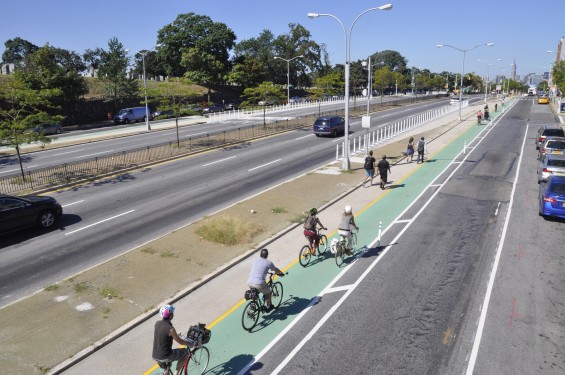
Jan. 8, 2018 By Nathaly Pesantez
Queens saw the fewest traffic fatalities in 2017 among the five boroughs in a year the city is calling the safest on record.
Pedestrian fatalities dropped 32 percent last year, according to Mayor Bill de Blasio’s announcement made earlier today. In 2017, 214 people, 101 of them pedestrians, died in traffic crashes compared to 231 people in 2016. Of the 231 people, 148 were pedestrians.
In Queens alone, 59 fatalities were recorded in 2017 compared to 65 in 2016, setting a new record low in traffic deaths for the borough. The prior record low for the borough was in 2011, which saw 63 fatalities.
Mayor de Blasio credits the fourth consecutive year of declining traffic fatalities to his Vision Zero initiative, which launched in 2014.
“Vision Zero is working,” de Blasio said. “The lower speed limit, increased enforcement and safer street designs are all building on each other to keep New Yorkers safe.”
Other Vision Zero highlights include continued work along Queens Boulevard, which saw a third consecutive year without a pedestrian or cyclist fatality in 2017.
“Queens Boulevard is proof that longstanding notions of intractable problems can be solved with determination, perseverance and fresh thinking,” said New York City Council Member Jimmy Van Bramer.
Fatalities have dropped 28 percent since 2013, according to the city, with pedestrian deaths dropping by 45 percent since.
While pedestrian deaths have dropped, 2017 saw an increase in motorcyclist and motor vehicle deaths, with 33 and 57 recorded deaths, respectively, from 19 and 46 in 2016. Last year also proved the deadliest year for bicyclists, with 23 deaths compared to 18 in 2016.
“In 2017, under the Mayor’s leadership, DOT’s work helped fuel a historic drop in pedestrian fatalities…” said DOT Commissioner Polly Trottenberg. “However, the number of lives lost on our streets is still too high, including the increases in fatalities we saw this year among cyclists, drivers and motorcyclists. We know we have much more work to do to fully achieve Vision Zero.”
13 Comments







This picture is such a fake! I live off Queens Blvd., where this picture represents. Between 58th and 56th Street. NEVER see people walking in bike lane! Hardly ever see bikes in bike lane! Usually they are going in wrong direction! That is what gets my attention! I drive or walk Queens Blvd. every day. Razi School is there, school buses and vehicles are usually there on school days.
I use the bike lane on QB quite often (not so much during Jan/Feb.) My dentist is on 61st street, I go to the bike shop on Roosevelt & 65th, and I also like Staples. The bike lane is great and much safer than biking on Roosevelt Avenue. Additionally, traffic is calmer since the bike lanes were added. Win win!
Are we not living in the same Borough/neighborhood? Cars are a menace! And in Western Queens not the primary form of transportation. We need protected bus lanes, bike lanes, pedestrian islands, speed bumps, anything and everything to prevent reckless driving. This city is WAY too densely populated for the amount of car traffic. It’s not sustainable and it literally KILLS people.
This photo was created for the presentation introducing the bike lane plan, so yes, it’s photoshopped but not part of some conspiracy. That doesn’t change the fact that street calming measures (like narrowing roads and installing protected bike lanes) save lives. And these numbers ARE for the entire borough. Not only Queens Blvd.
vision zero is a stupid name, if you had zero vision you’d be mowing down pedestrians and cyclists left and right.
Also known as patting themselves in the back, meanwhile I’ve NEVER ever seen anyone walk there, when there is a perfectly fine sidewalk, not only that there is never more than 1 or 2 bikers in any given hour biking through there. This above fake photoshop ridden picture makes it look like a beach town or some kind of scenic route, well there is some scenery — of a cemetery on the other side of the road.
Also who would have thought making cars go slower by installing ticket traps would reduce the accidents!? WOW. It has nothing to do with bike lanes, of course narrower roads mean less cars, slower cars, but I wish they had the guts to share the traffic fatalities everywhere, not just queens blvd. PS: There are no bike lanes on queens blvd from 40th to 33rd, what’s happening there?
You’re mad because traffic fatalities are down.
Between 40th and 33rd, Queens Blvd, traffic does the job of slowing down vehicles. If cars aren’t speeding, it makes it less likely for pedestrians and cyclists to be killed.
Angry parking comments in 3… 2…
as usual great photo-op – there has never been so many bikes nor people on these bike lanes — such a fib
they are so full of bologna — stats are fugged –
The previous low was before DeBlasio was in office. SS Post should show a real photo of Queens Blvd and not an artist’s rendering. You probably wouldn’t find anyone in the bike lanes in a real photo.
I’ll take a selfie & send it to you, okay? I see other bicyclists using it all the time. I never see you, so no wonder you are missing it all.